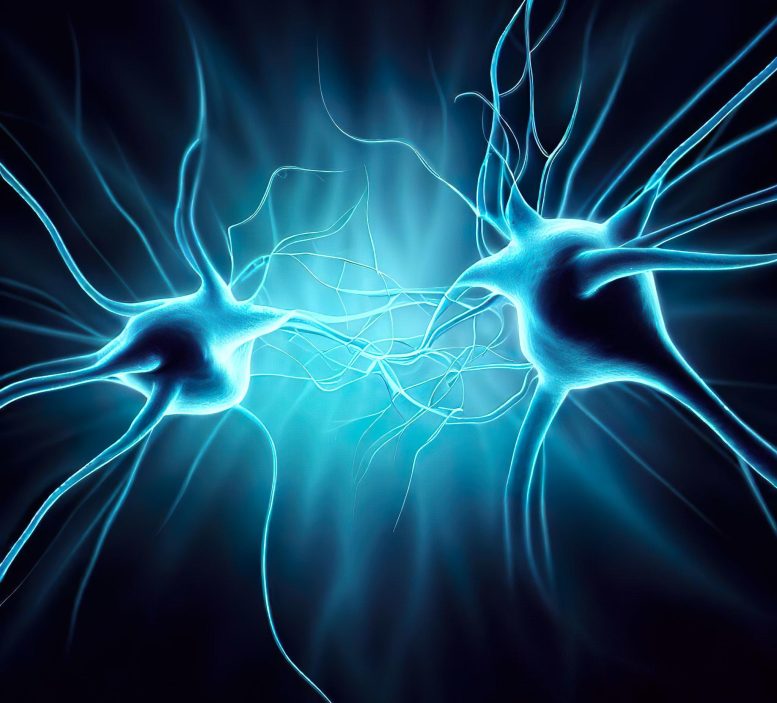
Forscher der Kyushu-Universität haben die chemischen Wege entdeckt, die die synaptische Beschneidung regulieren, eine kritische Phase in der Gehirnentwicklung, in der überschüssige und falsche neuronale Verbindungen abgebaut werden. Das Team fand heraus, dass bei Vorhandensein von Neurotransmittersignalen Rezeptordendriten geschützt sind, während andere Dendriten desselben Neurons auf einen zu beschneidenden Weg gesetzt werden, ein Mechanismus, der zur Verbesserung neuronaler Netzwerke beiträgt und zur korrekten Reifung des Gehirns beiträgt.
Die Wissenschaftler demonstrieren den Prozess, durch den Synapsen miteinander konkurrieren, und beschreiben, wie schwache und verrauschte Synapsen während der Entwicklung während der Evolution verworfen werden.
Wissenschaftler der Kyushu-Universität haben die Mechanismen hinter einem entscheidenden, aber oft übersehenen Stadium der Gehirnentwicklung entdeckt, das als synaptische Beschneidung bekannt ist.
Für ihre Studie verwendete das Forschungsteam Mitralzellen von Mäusen, eine Art Neuron im Riechsystem. Sie entdeckten, dass die Empfängerdendriten durch eine Reihe chemischer Wege geschützt werden, wenn Neuronen ein Neurotransmittersignal akzeptieren. Gleichzeitig regt die Depolarisation andere Dendriten derselben Zelle dazu an, einem separaten Weg zu folgen, der das Beschneiden fördert. Die Ergebnisse wurden kürzlich in der Fachzeitschrift veröffentlicht Entwicklungszelle.
Wie sich Neuronen verbinden und umgestalten, ist eine grundlegende Frage der Neurobiologie. Das Hauptkonzept geeigneter Netzwerke besteht darin, Neuronen mit anderen Neuronen zu bilden und zu verstärken und gleichzeitig überaktive und fehlerhafte Neuronen zu beschneiden.
Ein gebräuchlicher Satz bei der Neukonfiguration neuronaler Schaltkreise lautet „Alle Drähte gleichzeitig auslösen“ und „Wenn Sie nicht synchron sind, verlieren Sie Ihre Verbindung.“ Ersteres beschreibt, wie Neuronen, die Signale untereinander weiterleiten, dazu neigen, Verbindungen zu stärken, während letzteres dies ohne weiteres erklärt signalisieren, dass diese Verbindung abnimmt“, erklärt Professor Takeshi Imai von der School of Medical Sciences der Universität Kyushu, der die Studie leitete. „Es ist ein wesentlicher Reinigungsprozess für die richtige Reifung des Gehirns.“
Riechkolben einer Maus 2 Tage nach der Geburt mit Fluoreszenzanzeigesignalen. Das Video zeigt, dass die Glomeruli, die Signalwegstation im Riechkolben, automatisch Signale senden. Diese spontanen Signale führen schließlich zu einer ordnungsgemäßen Netzhautstreifenbildung und einer Beschneidung der Mitralzellen. Die Videoaufzeichnung erfolgte ex vivo mit zwei Personen[{“ attribute=““>photon microscopy. Credit: Kyushu University/Imai Lab
Over the decades, researchers—including Prof Imai—have explored the fundamental process of how neurons form and strengthen their connections. However, there had been one major gap in the process that few people were examining: how the connections are eliminated.
“The elimination of neuronal connections, what we call pruning, was something everybody in the field knew about and observed. But if you look at the literature, there was a lack of study on the exact mechanism that drove the process,” explains first author Satoshi Fujimoto.
Elimination of connections happens everywhere in the nervous system, for example in neuromuscular junctions, the neurons that send signals to your muscles to move. At first, the muscle fibers receive inputs from many motor neurons. As you grow, these connections are finetuned, where some are strengthened, and others are eliminated, until just one neuron connects to one muscle fiber. It is why you have awkward motor control and coordination at an early age.

In early development, neurons called mitral cells grow multiple branches to connect with multiple glomeruli. Like a bonsai, as development progresses branches get strengthened and pruned. But while researchers investigated closely the mechanism of branch strengthening, how pruning was induced remained under-studied. Kyushu University researchers found that when mitral cells receive the neurotransmitter glutamate, the subsequent signal triggers local suppression of RhoA, protecting that dendrite. At the same time, the depolarization activates the pruning machinery—controlled by RhoA—in dendrites that did not receive the glutamate input. The winner dendrite takes all. Credit: Kyushu University/Imai Lab
“We decided to investigate what exactly happens in neurons during remodeling, so, we looked into using mouse mitral cells, a type of cell housed in the olfactory bulb, the brain center involved in our sense of smell. In adults, mitral cells have a single connection to a signaling waystation called the glomerulus. But in early development mitral cells send branches into many glomeruli,” states Fujimoto. “As time progresses, these branches get pruned to leave a single strong connection. In the end, the mitral cells can sniff out only a specific type of smell.”
First, the team found that spontaneous waves of the neurotransmitter glutamate in the olfactory bulb facilitate dendrite pruning. The team then focused on the mitral cell’s inner signaling pathways. What they found was a unique protection/punishment machinery that would strengthen certain connections and kick off the pruning of others.
“We found that in the mitral cells it was the signaling from glutamate that was essential for pruning. When glutamate binds to its receptor NMDAR in a dendrite, it suppresses the pruning machinery molecule called RhoA,” continues Fujimoto. “This ‘save-me’ signal is important to protect it from pruning.”

From the moment mice are born, their mitral cells extend multiple dendrites into multiple glomeruli. They form branches and excitatory synapses in the glomerulus at around day three after birth. By day six, they form single dendrites through selective pruning. This makes it possible to receive information from only one type of olfactory receptor (odor sensor), which is the basis of odor discrimination. Credit: Kyushu University/Imai Lab
Upon the glutamate input, the mitral cell also depolarizes and fires a signal. The team also found that depolarization triggers the activation of RhoA in other dendrites of the same cell, and kicking off the pruning process. Simply put, the dendrite that receives the direct glutamate signal is protected, while the other dendrites get pruned.
“This ‘punishment’ signal for synapse elimination only acts on non-protected synapses, and it explains how only a strong connection becomes the winner and all the others mediating weak and noisy inputs become the losers,” Imai explains.
The team’s findings reveal new information about an over-looked but critical phase in neural development.
“Proper pruning of neuronal connections is just as important as the strengthening of the network. If it goes awry in either direction it can lead to different kinds of neurophysiological disorders. Too few connections have been linked to schizophrenia, whereas too many connections have been found in people with autism spectrum disorder, for example.” says Imai. “To understand these sorts of pathologies we need to look carefully at every step of development.”
Reference: “Activity-dependent local protection and lateral inhibition control synaptic competition in developing mitral cells in mice” by Satoshi Fujimoto, Marcus N. Leiwe, Shuhei Aihara, Richi Sakaguchi, Yuko Muroyama, Reiko Kobayakawa, Ko Kobayakawa, Tetsuichiro Saito and Takeshi Imai, 7 June 2023, Developmental Cell.
DOI: 10.1016/j.devcel.2023.05.004

„Unruhestifter. Begeisterter Popkultur-Fan. Fernseh-Junkie. Bierliebhaber. Analytiker. Vollkommener Speckgelehrter. Denker.“





More Stories
Elon Musk sagt, eine neue OpenAI-Demo habe ihn frustriert
Apple veröffentlicht iOS 17.5, macOS 14.5 und andere Updates mit der Einführung neuer iPads
Google entwickelt seine Pixel-Telefone jetzt unter Berücksichtigung des Anwendungsfalls